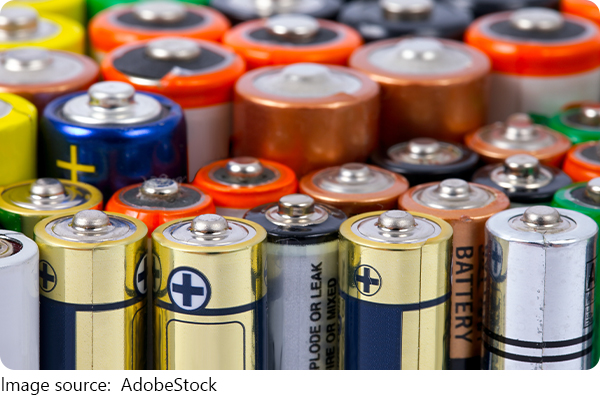Battery Chemistry Explained

Have you ever wondered what really powers your smartphone? You charge it, unplug it, and go about your day texting, scrolling, gaming, and calling—all without giving much thought to what's going on inside that slim battery pack.
But your phone's power source is not just a tiny box—it's a miniature chemistry lab that never stops working.
In this article, let's explore how chemistry fuels the batteries inside modern smartphones and how scientific innovation keeps pushing battery technology forward.
What's Inside a Phone Battery?
Most modern phones use lithium-ion batteries, a powerful and rechargeable type of battery. At their core, these batteries rely on chemical reactions to create and store energy. A typical lithium-ion battery is made of three key components:
• Anode: Usually made of graphite, which stores lithium ions during charging.
• Cathode: Typically composed of a lithium metal oxide like lithium cobalt oxide (LiCoO₂).
• Electrolyte: A liquid or gel substance that allows ions to move between the anode and cathode.
These components work together in a carefully balanced chemical dance that produces the electricity your phone needs.
How Charging Works
When you plug in your phone to charge it, electrical energy from the charger pushes lithium ions from the cathode to the anode through the electrolyte. At the same time, electrons travel through an external circuit (your phone's circuitry) to maintain electrical balance.
During this process:
• Lithium ions insert themselves into the anode.
• Electrons accumulate at the anode.
The battery stores this energy until you're ready to use your phone.
What Happens When You Use Your Phone?
Once you unplug the phone and start using it, the process reverses. Now the lithium ions leave the anode and move back to the cathode. The electrons also flow from the anode through the phone's circuits—powering the screen, processor, and apps—before rejoining the lithium ions at the cathode.
This flow of electrons is what powers your device. The battery continues to work this way until most lithium ions return to the cathode, at which point your phone needs to be recharged.
The Role of Chemistry
So how does chemistry make all this happen? It comes down to redox reactions—short for reduction and oxidation reactions.
• Oxidation occurs at the anode, where lithium atoms give up electrons and become lithium ions.
• Reduction happens at the cathode, where lithium ions regain electrons and return to a more stable state.
These controlled redox reactions allow energy to be released gradually and predictably, which is why your phone can last for hours instead of suddenly running out of power.
Why Lithium?
Lithium is the lightest metal and one of the most reactive elements in the periodic table. That makes it perfect for battery use. It offers:
• High energy density, meaning it can store a lot of energy in a small space.
• The ability to recharge hundreds of times with minimal performance loss.
• Lightweight design, which is crucial for keeping phones slim and portable.
No wonder lithium-ion chemistry became the gold standard for personal electronics!
Battery Safety and Chemistry
Battery safety is a direct result of how the internal chemistry is managed. If too many lithium ions are forced into the anode too quickly, or if there's a structural defect, dangerous outcomes like overheating can occur.
To prevent these issues, manufacturers use:
• Protective circuits to avoid overcharging or overheating.
• Separator membranes to prevent direct contact between anode and cathode.
• Temperature sensors to shut down the battery when it gets too hot.
All of this safety tech is built on careful chemical engineering.
What About Fast Charging?
Fast charging is not just about pumping in more electricity. It relies on advanced electrolyte compositions and precise control of ion flow to speed up the charging process without damaging the battery.
Newer batteries are designed to:
• Withstand higher current without degrading.
• Handle faster ion movement without causing chemical instability.
Chemistry is key to making fast charging both safe and efficient.
Battery Aging and Capacity Loss
Over time, you may notice that your phone doesn't hold a charge like it used to. This is due to chemical wear and tear inside the battery. Tiny deposits build up, and the movement of lithium ions becomes less efficient.
Other causes of battery aging include:
• Repeated charge cycles.
• Exposure to high temperatures.
• Incomplete ion exchange due to fast charging or heavy use.
Battery researchers are working on solutions like solid-state batteries and new electrode materials to combat these aging effects.

Future Battery Innovations
Scientists are exploring several new directions to improve battery performance:
• Solid-state batteries: Replace the liquid electrolyte with a solid material, making batteries safer and more energy-dense.
• Silicon-based anodes: These can hold more lithium than graphite, increasing battery capacity.
• Recycling innovations: Chemists are developing ways to safely extract lithium and cobalt from used batteries, reducing waste.
Each of these innovations depends on chemistry breakthroughs to become a reality.
From Chemistry to Connectivity
Whether you're video calling a friend, streaming music, or navigating a new city, you owe it all to the chemistry happening silently in your pocket. Every text, notification, and app tap is powered by controlled chemical reactions that took decades of research to develop.
So the next time your phone buzzes, give a silent thanks to the chemists, engineers, and scientists who turned lithium into power you can hold in your hand.
What Do You Think?
Did you know that so much science was packed into your phone battery? Which part surprised you the most? Let us know, and stay tuned—because battery chemistry is only going to get more exciting from here!

 · Astronomy Team
· Astronomy Team